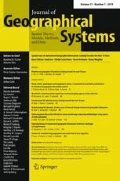Abstract.
This paper summarizes contributions of GIS in epidemiology, and identifies needs required to support spatial epidemiology as science. The objective of spatial epidemiology is to identify disease causes and correlates by relating spatial disease patterns to geographic variation in health risks. GIS supports disease mapping, location analysis, the characterization of populations, and spatial statistics and modeling. Although laudable, these accomplishments are not sufficient to fully identify disease causes and correlates. One reason is the failure of present-day GIS to provide tools appropriate for epidemiology. Two needs are most pressing. First, we must reject the static view: meaningful inference about the causes of disease is impossible without both spatial and temporal information. Second, we need models that translate space-time data on health outcomes and putative exposures into epidemiologically meaningful measures. The first need will be met by the design and implementation of space-time information systems for epidemiology; the second by process-based disease models.
Similar content being viewed by others
Author information
Authors and Affiliations
Rights and permissions
About this article
Cite this article
Jacquez, G. Spatial analysis in epidemiology: Nascent science or a failure of GIS?. J Geograph Syst 2, 91–97 (2000). https://doi.org/10.1007/s101090050035
Issue Date:
DOI: https://doi.org/10.1007/s101090050035



